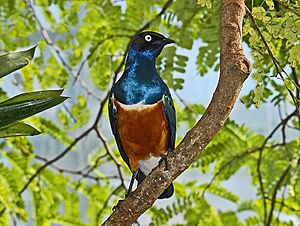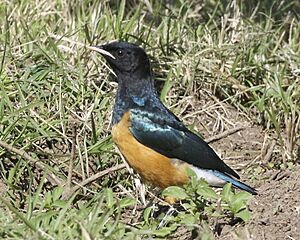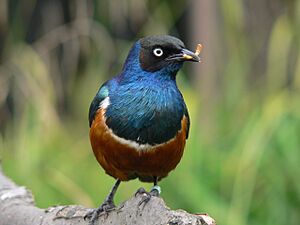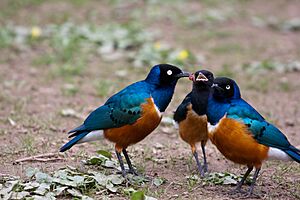Superb starling facts for kids
Quick facts for kids Superb starling |
|
|---|---|
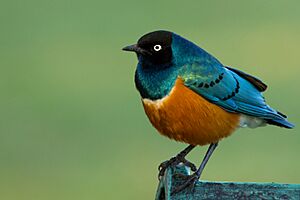 |
|
| Individual at Lake Naivasha, Kenya | |
| Conservation status | |
| Scientific classification | |
 |
|
| Superb starling distribution map |
The superb starling (Lamprotornis superbus) is a colorful bird from the starling family. These birds can live for more than 15 years when cared for by humans.
Contents
About the Superb Starling
Superb starlings are small birds, about 18 to 19 centimeters (7 to 7.5 inches) tall. They have short tails, a long thin beak, strong bodies, and powerful feet. Their feathers are incredibly shiny and colorful. This amazing shimmer comes from how tiny melanin pieces are arranged in their feathers. This creates bright blue and green colors, not from dyes, but from how light bounces off them.
Superb starlings look a lot like Hildebrandt's starling, another bird found in East Africa. You can tell them apart by their eyes: superb starlings have pale, creamy-white eyes, while Hildebrandt's starlings have red eyes. Also, only adult superb starlings have a white band across their chest.
Adult Colors
Adult superb starlings have a shiny, bronze-black color on their head. The area around their eyes and beak is black. Most of their body, including their chin, throat, chest, back of the neck, and upper back, is a glossy blue-green. The back of their neck often shows the brightest blue.
A thin white stripe separates their shiny chest from their red-orange belly and upper legs. The underside of their tail and wings are white. Their wings are a glossy metallic green with dark black spots. Their eyes are creamy-white, and their legs and beaks are black. Both male and female superb starlings look very similar. However, in birds kept by humans, males sometimes have a wider white chest band.
Young Bird Colors
Young superb starlings have duller feathers. They have the same color areas as adults, but their feathers are not as shiny, except for their tail and wing feathers. Their eyes are brown at first, then turn grayish-white. Their beak is yellowish with a dark tip. Their legs are brown. By about seven months old, they get their adult feathers. However, their eyes stay dark for a bit longer, and their beak might still have some yellow at the base.
Where Superb Starlings Live
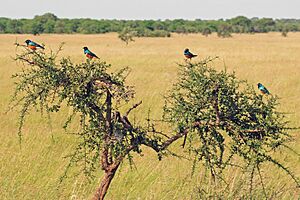
Superb starlings live in many different places. They like savannas, thorny bushes, open woodlands, and areas near lakes. You can also find them in gardens and farm fields. They live from sea level up to about 2,650 meters (8,700 feet) high. They usually stay away from very wet, low-lying areas.
These birds are found across a large part of East Africa. This includes countries like Ethiopia, Somalia, Uganda, Kenya, South Sudan, and Tanzania. Superb starlings often have large home areas, sometimes bigger than 0.5 square kilometers (0.2 square miles). When they are not in their home area, they are usually looking for food or going to get water.
Their groups can have more than 40 birds, with about an equal number of males and females. When it's not breeding season (usually the dry season), superb starlings might live with other starling types. These can include the Hildebrandt's starling and the Greater blue-eared starling. They have also been seen with other birds like the red-billed buffalo weaver and the white-headed buffalo weaver in Serengeti National Park in Tanzania. Living in mixed groups might help them find food and protect themselves from predators. However, during breeding season, superb starlings protect their territory and chase away other birds, especially if they get too close to their nests.
Superb Starling Behavior
Sounds and Calls
Superb starlings have a long, loud song with trills and chattering sounds. In the middle of the day, their song becomes softer and repeats phrases. They also make several harsh calls. One complex call sounds like a "shrill, screeching skerrrreeee-cherrrroo-tcherreeeeeet." When they are excited, they make a warning chirr and a repeated whit-chor-chi-vii. Some people compare their calls to the Common starling or the European robin.
Interestingly, in Amboseli National Park in Kenya, vervet monkeys have learned to understand the alarm calls of superb starlings. They know when the starlings are warning about predators in the air or on the ground, and they react properly.
What They Eat
Superb starlings mostly find their food on the ground, often near acacia trees. They are omnivores, meaning they eat both plants and animals. Their main food source is insects like termites, grasshoppers, moth larvae, beetles, mantids, and ants. They also eat berries, small fruits, and seeds. Sometimes, they even eat parts of dead animals. They can also get nectar from sisal flowers.
Superb starlings are usually quite calm and not afraid of people. They often look for food around human settlements and picnic areas. Unfortunately, in Tanzania, superb starlings can damage grapevines in vineyards. They also dig up sprouting wheat crops, which can harm farms.
Reproduction and Life Cycle
Nests
Superb starlings build their nests in thorny trees and bushes. They have also been seen nesting in tree holes, cliffs, or cracks in rocks. Nests in thorny trees are usually 1.5 to 6 meters (5 to 20 feet) above the ground and are well protected by the thorns. Sometimes, they even build their nests at the base of large bird of prey nests for extra safety.
Both male and female superb starlings help build the nests. These nests are large and made of twigs, lined with dry grass, and have an entrance on one side. Sometimes, they take over nests that belong to White-headed Buffalo Weavers. They might even remove the eggs that are already there.
Eggs and Parental Care
Superb starling eggs are a solid dark blue. They are about 24-26 millimeters (0.9-1.0 inches) long and 18-19 millimeters (0.7-0.75 inches) wide, weighing about 4.5 grams (0.16 ounces). Females usually lay 3 to 4 eggs.
Based on observations of birds kept by humans, the eggs hatch in 12-13 days. The young birds leave the nest surprisingly quickly, in just 18-24 days. Only the female bird sits on the eggs to keep them warm. Young birds are fed insects, mostly caterpillars and grasshoppers.
Superb starlings live in large social groups. Both the parents and other adult birds (called "alloparents") help care for the young. There can be 1 to 14 alloparents helping out. It seems that both parents are involved in raising the young until they can live on their own. The birds bringing food to the nestlings carry it in their beaks. This might be because starlings don't have a special pouch to store food, so they carry insects carefully to avoid digesting them too soon.
Social Life
In superb starling groups, young birds can either stay with their birth group or leave to join a new one. Birds who join new groups are not related to the birds already there. Because of this, they might have conflicts with the original group members throughout their lives.
Female superb starlings never breed within the group they were born into. However, both males born in the group and males who join from other groups can become breeding males in the same social group during breeding season. Even if there are male relatives and unrelated female partners available, males who join new groups often get the chance to breed.
Besides helping to raise their relatives' young, superb starlings also benefit from living in social groups. Being part of a larger group helps individual birds survive better. It also makes it more likely that birds in the group will successfully reproduce. This is probably because larger groups can better fight off predators, and bigger groups often have more food available in their territory.
Images for kids



